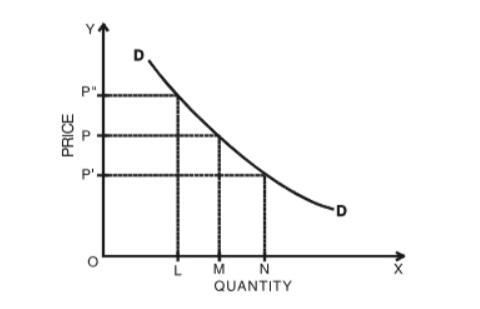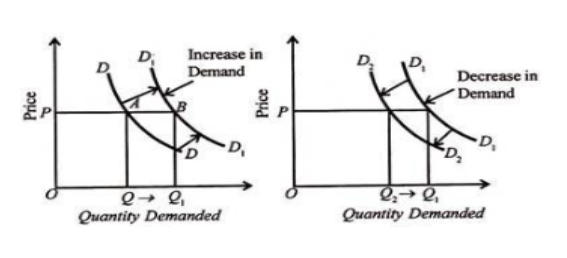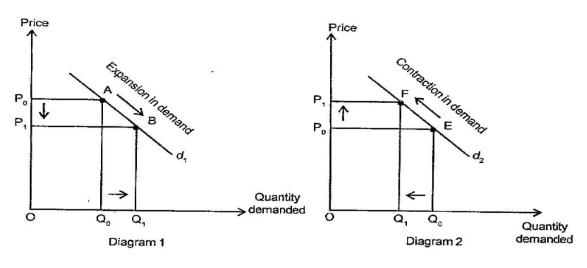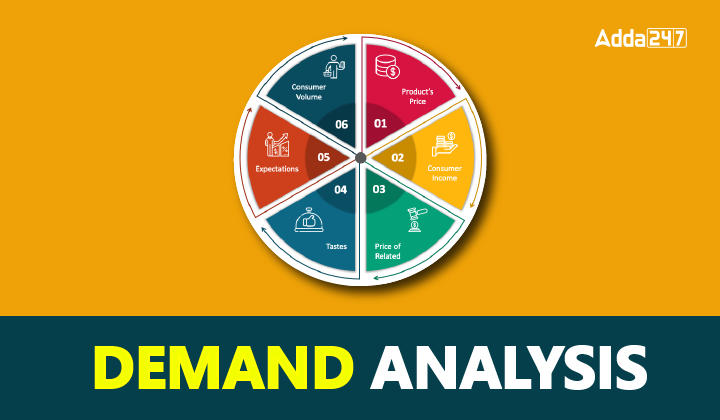Table of Contents
Demand analysis studies how price and other factors affect the volume of a product consumers are willing to buy. It guides businesses and policymakers in understanding market dynamics and making informed opinions. In this article, we will discuss the analytical view of the topic of demand analysis in detail which includes the meaning of demand, its features, the law of demand and changes in demand.
Demand Analysis Overview
Demand analysis examines how consumer choices are impacted by price, income, preferences, and market conditions. It helps us understand the relationship between price and volume demanded in a market. It investigates the way consumer behaviour reacts to price changes, making it easier to draw demand curves that showcase the quantity demanded at varying prices.
Meaning of Demand
Demand means the desire backed by the willingness to buy a commodity and the purchasing power to pay.
As stated by Stonier and Hague, in economics, “demand” signifies a request for goods that is supported by sufficient funds to cover the requested items.
According to Prof. Bober, “Demand refers to the various quantities of a given commodity or service which consumers would buy in one market in a given period of time at various prices or at various incomes or at various prices of related goods.”
What is Demand Analysis?
Demand Analysis involves the management’s decision-making process concerning production, cost distribution, advertising, inventory management, pricing, and related matters. Although, how much a firm produces depends on its production capacity how much of The production effort should be aligned with the potential demand for the product.
Demand Function
The demand function is the relationship between different factors affecting the demand. There are numerous economic, social as well and political factors affecting demand. The effect of all the factors on the amount demanded for the commodity is called the Demand Function. The demand function is of two types which are as follows:
| Functions of Demand | |
| Function | Explanation |
| Individual demand function | This is a fine representation that shows the volume of a product or services an individual consumer is willing and suitable to buy at various price situations, assuming other factors like income, preferences, and prices of affiliated goods remain constant. It’s a way to express an existent’s demand for a specific item grounded on their particular circumstances. |
| Market demand function | Market Demand Function This is a fine model that combines the individual demand functions of all consumers in a market to show the total volume of a product or service that all consumers are willing and suitable to buy at different prices. It provides an overall view of the demand for a product across the entire market, considering the combined goods of all individual preferences and circumstances. |
Law of demand
The Law of Demand asserts that there’s an inverse relationship between the price, and the volume demanded, similar to when the price increases the demand for the commodity decreases and when the price decreases the demand for the commodity increases, other effects remaining unchanged.
Assumptions of Law of Demand
Law is demand is grounded on certain assumptions which are as follows:
- This is no significant difference in consumers’ tastes and preferences.
- Income should remain constant.
- Prices of other goods shouldn’t change.
- There should be no cover for the commodity
- The commodity shouldn’t confer at any distinction
- The demand for the commodity should be nonstop
- People shouldn’t anticipate any change in the price of the commodity
Demand Schedule
A demand schedule most generally consists of two columns. The first column consists of the price for a product in ascending or descending order. The other column consists of the volume of the product asked or demanded at that price. The price is determined based on research on the market.
When the data in the demand schedule is graphed to produce the demand curve, it supplies a visual demonstration of the relationship between price and demand, allowing easy estimation of the demand for goods or services at any point with the curve.
Below is an example of a demand schedule for a product, let’s say “Refrigerator”:
| Price (in $) | Quantity Demanded |
| $500 | 30 |
| $800 | 18 |
| $1,000 | 10 |
In this example, the demand schedule shows the quantities of “Refrigerators” that consumers are willing to purchase at different price levels. As the price increases, the quantity demanded generally decreases, which is a typical pattern represented by a downward-sloping demand curve.
Demand Curve
A demand curve is a graphical representation of the relationship between the price of a product or service and the quantity of that product or service that consumers are willing and able to purchase at various prices, all else being equal. In economics, it is one of the fundamental tools used to understand how changes in price affect consumer behaviour in a market.

Changes in Demand
Changes in demand take place in two ways- Increase and Decrease in Demand and Extension and Contraction in Demand. Read the following section to learn about the two types of Changes in the Demand.
Increase and Decrease in Demand
| Increase in demand | Decrease in demand |
| An increase in demand means that consumers are now more willing and suitable to buy a product at various price situations. | A decrease in demand indicates that consumers are less willing and suitable to buy a product across different price points. |
| This can be when factors like rising consumer income, bettered consumer preferences, reduced prices of substitutes, lower prices of complements, larger population, effective advertising, positive consumer prospects, and favourable request trends come into play | This decline could be due to factors like falling consumer income, lowered consumer preferences, increased prices of substitutes, advanced prices of complements, a lower population, dropped advertising, negative consumer prospects, and adverse market trends. |
 Extension and Contraction in Demand
Extension and Contraction in Demand
| Extension in Demand | Contraction in Demand |
| Extension in demand occurs when the cost of a commodity decreases, leading to an increase in the volume demanded by consumers. | Contraction in demand happens when the price of a product increases, resulting in a drop in the volume demanded by consumers. |
| In other words, people are willing to buy more of the product as its price goes down, assuming that all other factors impacting demand remain unchanged. | As the price rises, people tend to buy less commodities, assuming that other demand factors remain constant. |
 Conclusion
Conclusion
In summary, demand analysis is the cornerstone of informed decision-making in the realm of economics. By studying the delicate relationship between price and consumer behaviour, we gain the tools to navigate the ever-changing landscape of supply and demand, fostering sustainable business growth and enhancing overall economic efficiency.
Download UGC NET Commerce Study Notes PDF
The direct Link to Download UGC NET Commerce Study Notes PDF has been mentioned below. Candidate can download Demand Analysis Study Notes PDF which has been mentioned below.
Download Demand Analysis Meaning, Functions & Laws Study Notes PDF




 UGC NET Commerce Syllabus 2025 PDF Downl...
UGC NET Commerce Syllabus 2025 PDF Downl...
 UGC NET Teaching Aptitude Questions Answ...
UGC NET Teaching Aptitude Questions Answ...
 UGC NET Philosophy Syllabus 2025 PDF Dow...
UGC NET Philosophy Syllabus 2025 PDF Dow...




